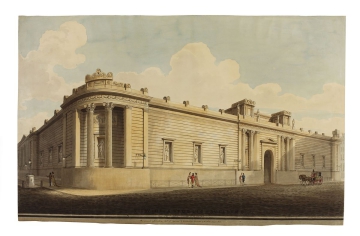
Browse
Reference number
Purpose
Aspect
Inscribed
Signed and dated
- Lincolns Inn Fields March 9th 1804 W[illia]m Rolfe
Hand
Watermark
Notes
The inscription refers to page 154 of Dallaway's Anecdotes of the Arts in England, which mentions the Bank of England's façade built by Sir Robert Taylor during his Surveryorship at the Bank in 1765: 'at the Bank, much caprice appears to have been indulged. In the original building there is nothing remarkable, but the wings and corridore added by Sir Robert Taylor would have better suited a lawn than a street. No foreigner, from the external elevation of the great magazine of national wealth, could possibly guess that such was its destination. Mr. Soane's massive wall with horizontal stripes, instead of rustic work, and his gateway, finished by sarcophagi, instead of a pediment, would not much help him in his conjecture' (op. cit. p.154). The other reference is to Pursuits of Literature, written by Thomas James Mathias in 1794. A mention of Chambers and Soane in the satirical poem is followed with a footnote: 'Two celebrated architects. The professional knowledge of Sir W. Chambers, Knight, (of most heroic memory) was profound and substantial. Mr Soane has more fancy and airiness of design, and is certainly a man of information and ingenuity. But he indulges himself a little too much in extravanganzas and whims. See the Bank.' (op. cit. p.336)
Literature
Level
Exhibition history
Sir John Soane's collection includes some 30,000 architectural, design and topographical drawings which is a very important resource for scholars worldwide. His was the first architect’s collection to attempt to preserve the best in design for the architectural profession in the future, and it did so by assembling as exemplars surviving drawings by great Renaissance masters and by the leading architects in Britain in the 17th and 18th centuries and his near contemporaries such as Sir William Chambers, Robert Adam and George Dance the Younger. These drawings sit side by side with 9,000 drawings in Soane’s own hand or those of the pupils in his office, covering his early work as a student, his time in Italy and the drawings produced in the course of his architectural practice from 1780 until the 1830s.
Browse (via the vertical menu to the left) and search results for Drawings include a mixture of Concise catalogue records – drawn from an outline list of the collection – and fuller records where drawings have been catalogued in more detail (an ongoing process).

